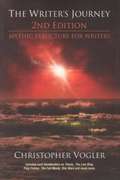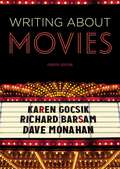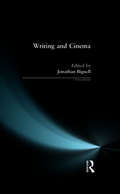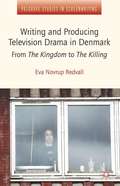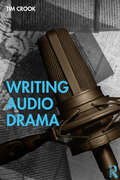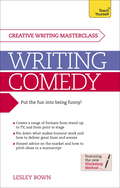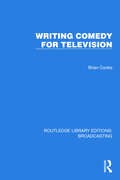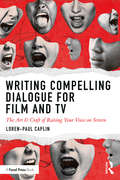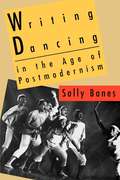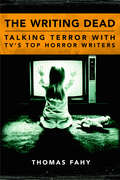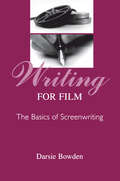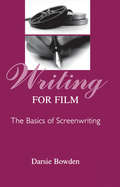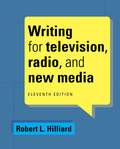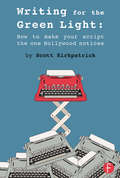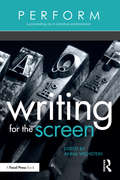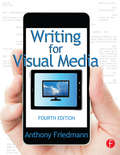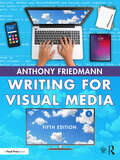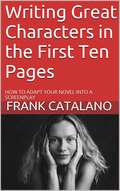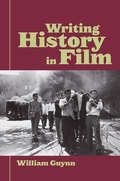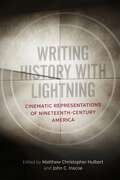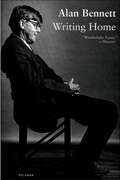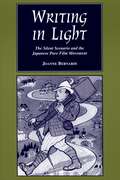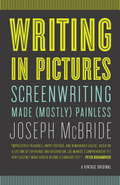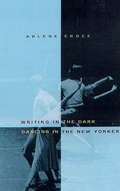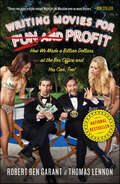- Table View
- List View
The Writer's Journey, Second Edition: Mythic Structure for Writers
by Christopher VoglerThe Writer's Journey sets forth archetypes common in what Vogler calls "the hero's journey," the mythic structure that he claims all stories follow. In the book's first section, he lists the different kinds of typological characters who appear in stories. In the second, he discusses the stages of the journey through which the hero generally passes. The final, supplementary portion of the book explains in detail how films like Titanic and The Full Monty follow the patterns he has outlined.
Writing About Movies (Fourth Edition)
by Karen Gocsik Dave Monahan Richard BarsamWriting About Movies offers students two books in one: a handy guide to the process of academic writing and a brief but thorough introduction to the basics of film form, film theory, and film analysis. Written by the director of the Warren College Writing Program at University of California, San Diego, and the authors of the leading introductory film studies text, Writing About Movies is the only writing guide a student of film will need.
Writing and Cinema (Crosscurrents)
by Jonathan BignellThis collection of essays examines the ways in which writing and cinema can be studied in relation to each other. A wide range of material is presented, from essays which look at particular films, including The Piano and The English Patient, to discussions of the latest developments in film studies including psychoanalytic film theory and the cultural study of film audiences. Specific topics that the essays address also include: the kinds of writing produced for the cinema industry, advertising, film adaptations of written texts and theatre plays from nineteenth century 'classic' novels to recent cyberpunk science fiction such as Blade Runner and Starship Troopers. The essays deal with existing areas of debate, like questions of authorship and audience, and also break new ground, for example in proposing approaches to the study of writing on the cinema screen. The book includes a select bibliography, and a documents section gives details of a range of films for further study.
Writing and Producing Television Drama in Denmark
by Eva Novrup RedvallOffering unique insights into the writing and production of television drama series such as The Killing and Borgen, produced by DR, the Danish Broadcasting Corporation, Novrup Redvall explores the creative collaborations in writers' rooms and 'production hotels' through detailed case studies of Denmark's public service production culture.
Writing Audio Drama
by Tim CrookWriting Audio Drama is a comprehensive and intelligent guide to writing sound drama for broadcasting and online production. The book uses new and original research on the history of writing radio plays in the UK and USA to explore how this has informed and developed the art form for more than 100 years. Audio drama in the context of podcasting is now experiencing a global and exponential expansion. Through analysis of examples of past and present writing, the author explains how to originate and craft drama which can explore deeply psychological and intimate themes and achieve emotional, truthful, entertaining, and thought-provoking impact. Practical analysis of the key factors required to write successful audio drama is covered in chapters focusing on audio play beginnings and openings, sound story dialogue, sustaining the sound story, plotting for sound drama and the best ways of ending audio plays. Each chapter is supported by extensive companion online resources expanding and supporting the writers and subjects discussed and explored, and extensive information on how to access online many exemplar and model sound dramas referenced in the chapters. This textbook will be an important resource for undergraduate and postgraduate students taking modules and courses on radio drama, theatre and media drama, audio theatre, audio drama, scriptwriting, media writing.
Writing Comedy: How to use funny plots and characters, wordplay and humour in your creative writing
by Lesley BownLearn how to write comedy that makes people laugh.Masterclass: Writing Comedy will reveal to both beginners and experienced writers the distinctive features that mark out comedy from other forms of creative writing. Having identified these, it will help you then to unlock your inner anarchist, and explore the different elements of comedy, using a combination of practical exercises, insight and creative inspiration. Whatever your preferred comic genre, you will find guidance on everything from wordplay and visual humour to plots, comedy characters and different styles.A section on performance will help you to hone stand-up skills, while chapters on stage and screen will give techniques and tips on how to craft a sitcom or create a sketch show. Finally, there is a uniquely frank but useful section on the realities of the markets, and the actualities of going it alone with self-publishing and self-promotion - or the tools you need to successfully pitch an idea or comic manuscript.ABOUT THE SERIESThe Teach Yourself Creative Writing series helps aspiring authors tell their stories. Covering a range of genres from science fiction and romantic novels to illustrated children's books and comedy, this series is packed with advice, exercises, and tips for unlocking creativity and improving your writing. And because we know how daunting the blank page can be, we set up the Just Write online community, at tyjustwrite.com, for budding authors and successful writers to connect and share.
Writing Comedy for Television (Routledge Library Editions: Broadcasting #40)
by Brian CookeWriting Comedy for Television (1983) is a practical, step-by-step manual about how and what to write. It contains many examples from the scripts of various sitcoms and sketch shows. It demonstrates how to construct a storyline for a series, how to lay out a sketch, who to pitch to, and how a television comedy is put together.
Writing Compelling Dialogue for Film and TV: The Art & Craft of Raising Your Voice on Screen
by Loren-Paul CaplinWriting Compelling Dialogue for Film and TV is a practical guide that provides you, the screenwriter, with a clear set of exercises, tools, and methods to raise your ability to hear and discern conversation at a more complex level, in turn allowing you to create better, more nuanced, complex and compelling dialogue. The process of understanding dialogue writing begins with increasing writers’ awareness of what they hear. This book provides writers with an assortment of dialogue and language tools, techniques, and exercises and teaches them how to perceive and understand the function, intent and thematic/psychological elements that dialogue can convey about character, tone, and story. Text, subtext, voice, conflict, exposition, rhythm and style are among the many aspects covered. This book reminds us of the sheer joy of great dialogue and will change and enhance the way writers hear, listen to, and write dialogue, and along the way aid the writers’ confidence in their own voice allowing them to become more proficient writers of dialogue. Written by veteran screenwriter, playwright, and screenwriting professor Loren-Paul Caplin, Writing Compelling Dialogue is an invaluable writing tool for any aspiring screenwriter who wants to improve their ability to write dialogue for film and television, as well as students, professionals, and educators.
Writing Dancing in the Age of Postmodernism
by Sally BanesDrawing of the postmodern perspective and concerns that informed her groundbreaking Terpsichore in Sneakers, Sally Banes's Writing Dancing documents the background and developments of avant-garde and popular dance, analyzing individual artists, performances, and entire dance movements. With a sure grasp of shifting cultural dynamics, Banes shows how postmodern dance is integrally connected to other oppositional, often marginalized strands of dance culture, and considers how certain kinds of dance move from the margins to the mainstream.Banes begins by considering the act of dance criticism itself, exploring its modes, methods, and underlying assumptions, and examining the work of other critics. She traces the development of contemporary dance from the early work of such influential figures as Merce Cunningham and George Balanchine to such contemporary choreographers as Molissa Fenley, Karole Armitage, and Michael Clark. She analyzes the contributions of the Judson Dance Theatre and the Workers' Dance League, the emergence of Latin postmodern dance in New York, and the impact of black jazz in Russia. In addition, Banes explores such untraditional performance modes as breakdancing and the "drunk dancing" of Fred Astaire.Ebook Edition Note: Ebook edition note: All images have been redacted.
The Writing Dead: Talking Terror with TV'S Top Horror Writers (Television Conversations Series)
by Thomas FahyThe Writing Dead features original interviews with the writers of today's most frightening and fascinating shows. They include some of television's biggest names—Carlton Cuse (Lost and Bates Motel), Bryan Fuller (Hannibal, Dead Like Me, Wonderfalls, and Pushing Daisies), David Greenwalt (Angel and Grimm), Gale Anne Hurd (The Walking Dead, The Terminator series, Aliens, and The Abyss), Jane Espenson (Buffy the Vampire Slayer and Battlestar Galactica), Brian McGreevy (Hemlock Grove), Alexander Woo (True Blood), James Wong (The X-Files, Millennium, American Horror Story, and Final Destination), Frank Spotnitz (The X-Files and Millennium), Richard Hatem (Supernatural, The Dead Zone, and The Mothman Prophecies), Scott Buck (Dexter), Anna Fricke (Being Human), and Jim Dunn (Haven). The Writing Dead features thought-provoking, never-before-published interviews with these top writers and gives the creators an opportunity to delve more deeply into the subject of television horror than anything found online. In addition to revealing behind-the-scene glimpses, these writers discuss favorite characters and storylines and talk about what they find most frightening. They offer insights into the writing process reflecting on the scary works that influenced their careers. And they reveal their own personal fascinations with the genre. The thirteen interviews in The Writing Dead also mirror the changing landscape of horror on TV—from the shows produced by major networks and cable channels to shows made exclusively for online streaming services such as Netflix and Amazon Studios. The Writing Dead will appeal to numerous fans of these shows, to horror fans, to aspiring writers and filmmakers, and to anyone who wants to learn more about why we like being scared.
Writing for Film: The Basics of Screenwriting
by Darsie BowdenIn this introduction to screenwriting, author Darsie Bowden provides sage, real-world advice and instruction on the process of writing film screenplays. This text will help budding screenwriters to structure their dramas, refine their characterizations, and craft their language, while also introducing them to the appropriate screenplay formats. It covers the complexities of writing for the screen and points out the contradictions to expect if readers pursue this work as a career. In addition to covering the elements of the dramatic film screenplay, Bowden discusses writing for such "alternative" markets as documentaries, independent films, experimental films, and other non-Hollywood options. Features of the text include:guidelines for working as a screenwriter;applications and exercises to enhance skills;suggested readings for further development; anda comprehensive list of resources for screenwriting.Successful writing for film lies in being able to heighten one's perceptive abilities about the world and to communicate those perceptions in a cinematic way. In this text, Bowden introduces readers to an approach to screenwriting that will help them see the world in a different way and write about it using different genres and media. This most valuable skill prepares readers for the range of possibilities they will encounter on the path to successful screenwriting.
Writing for Film: The Basics of Screenwriting
by Darsie BowdenIn this introduction to screenwriting, author Darsie Bowden provides sage, real-world advice and instruction on the process of writing film screenplays. This text will help budding screenwriters to structure their dramas, refine their characterizations, and craft their language, while also introducing them to the appropriate screenplay formats. It covers the complexities of writing for the screen and points out the contradictions to expect if readers pursue this work as a career. In addition to covering the elements of the dramatic film screenplay, Bowden discusses writing for such "alternative" markets as documentaries, independent films, experimental films, and other non-Hollywood options. Features of the text include:guidelines for working as a screenwriter;applications and exercises to enhance skills;suggested readings for further development; anda comprehensive list of resources for screenwriting.Successful writing for film lies in being able to heighten one's perceptive abilities about the world and to communicate those perceptions in a cinematic way. In this text, Bowden introduces readers to an approach to screenwriting that will help them see the world in a different way and write about it using different genres and media. This most valuable skill prepares readers for the range of possibilities they will encounter on the path to successful screenwriting.
Writing For Television, Radio, And New Media
by Robert L. HilliardYou can trust Hilliard's WRITING FOR TELEVISION, RADIO, AND NEW MEDIA to provide you with thorough and up-to-date coverage of the principles, techniques, and approaches of writing for television, radio, and the Internet. You'll learn about writing for a variety of formats, such as commercials, news and sports, documentaries, reality programs, talk shows, interviews, music programs, and drama and sitcoms. The book's comprehensive content, excellent organization, attention to form, and good examples ensure that you will be well trained for a career in the field.
Writing for the Green Light: How to Make Your Script the One Hollywood Notices
by Scott KirkpatrickTailor your screenplay to sell. Find out what Hollywood script readers, producers, and studio executives want in a screenplay (and why) from someone who’s been there. Discover what it takes to begin a lasting career as a screenwriter. Peppered with interviews from established professionals, Writing for the Green Light: How to Make Your Script the One Hollywood Notices gives you a sharp competitive edge by showcasing dozens of everyday events that go on at the studios but are rarely if ever discussed in most screenwriting books. With his behind-the-scenes perspective, Scott Kirkpatrick shows you why the system works the way it does and how you can use its unwritten rules to your advantage. He answers such questions as: Who actually reads your script? How do you pique the interest of studios and decision makers? What do agents, producers, and production companies need in a script? How much is a script worth? What are the best genres for new writers and why? What are real steps you can take to ‘break in’ to television writing? How do you best present or pitch a project without looking desparate? How do you negotiate a contract without an agent? How do you exude confidence and seal your first deal? These and other insights are sure to give you and your screenplay a leg-up for success in this competitive landscape!
Writing for the Screen (PERFORM)
by Anna WeinsteinWriting for the Screen is a collection of essays and interviews exploring the business of screenwriting. This highly accessible guide to working in film and television includes perspectives from industry insiders on topics such as breaking in; pitching; developing and nurturing business relationships; juggling multiple projects; and more. Writing for the Screen is an ideal companion to screenwriting and filmmaking classes, demystifying the industry and the role of the screenwriter with real-world narratives and little-known truths about the business. With insight from working professionals, you’ll be armed with the information you need to pursue your career as a screenwriter. Contains essays by and interviews with screenwriting consultants, television writers, feature writers, writer-directors of independent film, producers, and professors. Offers expert opinions on how to get started, including preparing your elevator pitch, finding mentors, landing an internship, and moving from an internship to the next step in your career. Reveals details about taking meetings, what development executives are looking for in a screenwriter, how and when to approach a producer, and how to pitch. Explores strategies for doing creative work under pressure, finding your voice, choosing what to write, sticking with a project over the long haul, overcoming discrimination, and reinventing yourself as a writer. Illuminates the business of screenwriting in the United States (New York and Los Angeles) as compared to other countries around the globe, including England, Ireland, Peru, France, Australia, and Belgium.
Writing for Visual Media
by Anthony FriedmannThis updated edition of Writing for Visual Media will enable you to understand the nature of visual writing that lies behind the content of all visual media. This unique kind of writing must communicate to audiences through content producers, since audiences don't read the script. Most media content provides a solution to a communication problem, which the writer must learn to analyze and solve before writing the script. The Fourth Edition strengthens the method for creating content and writing in the correct language and established format for each visual medium, including commercial communication such as ads and PSAs, corporate communications, and training. An extended investigation into dramatic theory and how entertainment narrative works is illustrated by examples and detailed analysis of scenes, scripts and storylines, saving you designed to save writers from typical pitfalls and releasing your creative powers of invention. Writing for Visual Media will help you to develop an improved foundation for understanding interactive media and writing for non-linear content, while gaining the tools to effectively connect with your audience like a professional. Purchase of this book includes access to the companion website, which provides: Sample scripts and video clips of those produced scripts An interactive glossary of camera shots, movements, and transitions Storyboards, scripts, screenplays, and links to industry resource Instructor materials such as PowerPoint lecture slides, a sample syllabus, and a test bank. Visit the site at www.routledgetextbooks.com/textbooks/9780415815857
Writing for Visual Media
by Anthony FriedmannWriting for Visual Media provides writers with an understanding of the nature of visual writing behind all visual media. Such writing is vital for directors, actors, and producers to communicate content to audiences. Friedmann provides an extended investigation into dramatic theory and how entertainment narrative works, illustrated by examples and detailed analysis of scenes, scripts, techniques, and storylines. This new edition has a finger on the pulse of the rapidly evolving media ecosystem and explains it in the context of writing and creating content. Friedmann lays out many of the complex professional, creative, and commercial issues that a writer needs to understand in order to tell engaging stories and construct effective and professional screenplays. This new edition includes: A new chapter on storytelling A fresh examination of dramatic theory and how to apply it to constructing screenplays Updated discussion of mobile platforms A lengthened discussion of copyright, ethics, and professional development issues An updated companion website with sample scripts and corresponding videos, an interactive glossary, sample storyboards and screenplays, links to industry resources, and materials for instructors such as slides, a syllabus, and a test bank.
Writing Great Characters in the First Ten Pages: How to Adapt Your Novel Into a Screenplay
by Frank CatalanoWriters of fiction and non-fiction and industry professionals from the publishing business primarily attended the 25th Annual Writer's Conference. Mr. Catalano's seminars focused upon those writers seeking to adapt their novels into screenplays. The complete list of seminar presentations by Frank Catalano for this conference is: BOOK 1: WRITE GREAT CHARACTACTERS IN THE FIRST TEN PAGES BOOK 2: WRITING ON YOUR FEET - IMPROVISATIONAL TECHNIQUES FOR WRITERS BOOK 3: START YOUR STORY AT THE END: FOR WRITERS BOOK 4: THE FIRST TEN PAGES BOOK 5: BOOK TO SCREEN BOOK 6: ACTING IT OUT - IMPROVISATIOINAL TECHNIQUES FOR WRITERS II BOOK 7: WRITE GREAT DIALOGUE
Writing History in Film
by William GuynnHistorical film has been an important genre since the earliest silent films. The French Revolution, the American Civil War, the conquest of the New World, World War II--all have been repeatedly represented in film. But how do we distinguish between fictionalized spectacle and authentic historical representation? Writing History in Film sets out the narratological, semiological, rhetorical, and philosophical bases for understanding how film can function as a form of historical interpretation and representation. With case studies and an interdisciplinary approach, William Guynn examines the key issues facing film students and scholars, historians, and anyone interested in how we see our historical past.
Writing History with Lightning: Cinematic Representations of Nineteenth-Century America
by Matthew C. Hulbert John C. Inscoe Kenneth Greenberg William L. Andrews Lesley J. Gordon John David Smith Jonathon Sarris Catherine Clinton John F. Marszalek Ryan Keating Joseph Beilein Brian Rouleau Donna Barbie Allison Dorsey Stephen Whitfield Marcus Rediker Nicole Etcheson Diane Miller Sommerville Graham Hodges Drew Swanson Michael Burlingame Tom Lee James Crisp Matthew Stanley Kevin Waite Jacob LeeFilms possess virtually unlimited power for crafting broad interpretations of American history. Nineteenth-century America has proven especially conducive to Hollywood imaginations, producing indelible images like the plight of Davy Crockett and the defenders of the Alamo, Pickett’s doomed charge at Gettysburg, the proliferation and destruction of plantation slavery in the American South, Custer’s fateful decision to divide his forces at Little Big Horn, and the onset of immigration and industrialization that saw Old World lifestyles and customs dissolve amid rapidly changing environments. Balancing historical nuance with passion for cinematic narratives, Writing History with Lightning confronts how movies about nineteenth-century America influence the ways in which mass audiences remember, understand, and envision the nation’s past. In these twenty-six essays—divided by the editors into sections on topics like frontiers, slavery, the Civil War, the Lost Cause, and the West—notable historians engage with films and the historical events they ostensibly depict. Instead of just separating fact from fiction, the essays contemplate the extent to which movies generate and promulgate collective memories of American history. Along with new takes on familiar classics like Young Mr. Lincoln and They Died with Their Boots On, the volume covers several films released in recent years, including The Revenant, 12 Years a Slave, The Birth of a Nation, Free State of Jones, and The Hateful Eight. The authors address Hollywood epics like The Alamo and Amistad, arguing that these movies flatten the historical record to promote nationalist visions. The contributors also examine overlooked films like Hester Street and Daughters of the Dust, considering their portraits of marginalized communities as transformative perspectives on American culture. By surveying films about nineteenth-century America, Writing History with Lightning analyzes how movies create popular understandings of American history and why those interpretations change over time.
Writing Home
by Alan BennettBringing together the hilarious, revealing, and lucidly intelligent writing of one of England's best known literary figures, Writing Home includes the journalism, book and theater reviews, and diaries of Alan Bennett, as well as "The Lady in the Van," his unforgettable account of Miss Shepherd, a London eccentric who lived in a van in Bennett's garden for more than twenty years. This revised and updated edition includes new material from the author, including more recent diaries and his introduction to his Oscar-nominated screenplay for The Madness of King George. A chronicle of one of the most important literary careers of the twentieth century, Writing Home is a classic history of a life in letters.
Writing in Light: The Silent Scenario and the Japanese Pure Film Movement
by Joanne BernardiWhile most people associate Japanese film with modern directors like Akira Kurosawa, Japan's cinema has a rich tradition going back to the silent era. Japan's "pure film movement" of the 1910s is widely held to mark the birth of film theory as we know it and is a touchstone for historians of early cinema. Yet this work has been difficult to access because so few prints have been preserved. Joanne Bernardi offers the first book-length study of this important era, recovering a body of lost film and establishing its significance in the development of Japanese cinema. Building on a wealth of original-language sources--much of it translated here for the first time--she examines how the movement challenged the industry's dependence on pre-existing stage repertories, preference for lecturers of intertitles, and the use of female impersonators. Bernardi provides in-depth analysis of key scripts--The Glory of Life, A Father's Tears, Amateur Club, and The Lust of the White Serpent--and includes translations in an appendix. These films offer case studies for understanding the craft of screenwriting during the silent era and shed light on such issues as genre, authorship and control, and gender representation. Writing in Light helps fill important gaps in the history of Japanese silent cinema. By identifying points at which "pure film" discourse merges with changing international trends and attitudes toward film, it offers an important resource for film, literary, and cultural historians.
Writing in Pictures
by Joseph McbrideWriting in Pictures is a refreshingly practical and entertaining guide to screenwriting that provides what is lacking in most such books: a clear, step-by-step demonstration of how to write a screenplay.Seasoned screenwriter and writing teacher Joseph McBride breaks down the process into a series of easy, approachable tasks, focusing on literary adaptation as the best way to learn the basics and avoiding the usual formulaic approach. With its wealth of useful tips, along with colorful insights from master screenwriters past and present, this book is invaluable for anyone who wants to learn the craft of screen storytelling.
Writing in the Dark, Dancing in the New Yorker
by Arlene CroceArlene Croce was The New Yorker's dance critic, a post created for her. Her entertaining, forthright, passionate reviews have revealed the logic and history of ballet, modern dance, and their postmodern variants to a generation of theatergoers.
Writing Movies for Fun and Profit: How We Made a Billion Dollars at the Box Office and You Can, Too!
by Robert Ben Garant Thomas LennonThis isthe only screenwriting guide by two guys who have actually done it (instead of some schmuck who just gives lectures about screenwriting at the airport Marriott); “These guys are proof that with no training and little education, ANYONE can make it as a screenwriter” (Paul Rudd).Robert Ben Garant and Thomas Lennon’s movies have made over a billion dollars at the box office—and now they show you how to do it yourself! This book is full of secret insider information about how to conquer the Hollywood studio system: how to write, pitch, structure, and get drunk with the best of them. Well…maybe not the best of them, but certainly the most successful. (If you’re aiming to win an Oscar, this is not the book for you!) But if you can type a little, and can read and speak English—then you too can start turning your words into stacks of money!This is the only screenwriting book you will ever need (because all other ones pretty much suck). In these pages, Garant and Lennon provide the kind of priceless tips you won’t find anywhere else, including:-The art of pitching -Getting your foot in the door -Taking notes from movie stars -How to get fired and rehired -How to get credit and royalties!And most important: what to buy with the huge piles of money you’re going to make!Writing Movies for Fun and Profit will take you through the highs and lows of life as a professional screenwriter. From the highs of hugging Gisele Bündchen and getting kung fu punched by Jackie Chan to the soul-crushing lows of Herbie: Fully Loaded.Read this book and you’ll have everything you need to make your first billion the old-fashioned way—by “selling out” in show business!A portion of the authors’ proceeds from this book are being contributed to the USO of Metropolitan Washington, a private, nonprofit organization dedicated to serving active duty military members and their families in the greater Washington, DC, region.
